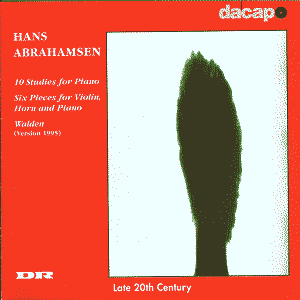The CD booklet is graced with a picture of Hans Abrahamsen,
just half a profiled face reflected through a bottle which may well
show the rest of his features. As you will discover if you read on this
is a very appropriate metaphor for this recording.
Abrahamsen made a quick start as a composer. I can
remember hearing a work of his in the Queen Elizabeth Hall c.1972 when
he was probably still a student, as was I at the time. But like many
composers who write prolifically when young he came to a full stop and
dried up, after completing 7 of the 10 studies for piano recorded here.
Why? Sometimes it is an inner need to take stock. Possibly to reconsider
one's language. Or it may be to move in completely another direction.
Perhaps the composer has nothing further to say. More likely the inner
drive goes due to criticism, lack of support by a publisher or lack
of performances and no recordings on the horizon. Well whatever the
reason Abrahamsen stopped writing new works.
What he did was to take six of the studies and adapt
them for the combination for violin, horn and piano, not just ‘orchestrating’
them but discovering new material within the ideas, adding a little
or more commonly taking away or (as Thomas Michelsen in the CD booklet
describes it) "rubbing out" textures. When in a fallow patch it can
often be good for a composer to write a study or fugue or complete some
sort of exercise, this is probably the raison d’être behind these
works.
It is therefore very interesting to see into the composer’s
mind and to compare movements. Track 1 ‘Traumlied’ in the Studies relates
to Serenade, track 11 in the Six Pieces. Track 3 related to track 12
both pieces called ‘Arabesque’ or ‘Arabeske’. Particularly interesting
are the two versions of ‘Blues’: track 7 and track 13. It is an amusing
and informative exercise to programme these tracks side by side, especially
so in the case of Piano Study number 4, ‘Ende’, and its related ‘Marcia
Funèbre’ in the Six Pieces. Here the chords are held but with
certain notes highlighted by the horn or violin and sustaining after
the piano has died away.
The Piano Studies are neatly planned, the first four
with German titles, the next three with American titles like ‘Boogie-Woogie’
and the last three consist of two French ones and one Italian. The latter
is the extraordinary and sombre ‘Le trombe del mattino’ with its prolonged
silences and chordal punctuation. It is however worth remembering that
these last three studies were written in 1998 as Abrahamsen was coming
to the end of his "fallow" period and are therefore not be found in
the Six Pieces of 1984.
The act of making something new out of something old
can be heard in ‘Walden’. In 1978 it was originally composed for flute,
oboe, clarinet, french horn, and bassoon and was recorded under its
original title 'Winternacht' by the London Sinfonietta (on Da Capo 8.224080)
but in 1995 the composer revisited the piece for its present combination.
The sound has become more romantic, less cool - even more dreamlike.
It has a logical growth and reaches a light-hearted dénouement
with a brief poly-rhythmic Allegretto grazioso. The work does
not outstay its ten minutes.
I must say at this point how consistently disappointed
I am by the standard of recording quality that Da Capo seem to produce
for their chamber music discs. Here again, as in the Vagn Holmboe Quartet
volumes the sound is recessed, the piano tone often harsh in the upper
register and a general feeling that the equipment used is no better
than my own mini-tape recorder. As a listener you get used to the sound
and learn to accommodate it, but I feel that it is just not acceptable
for a disc at full price.
As far as I can tell the performances are ideal and
the music is played with care and understanding. Anne Marie Anbildskov
gave the first performance of Abrahamsen’s Piano Concerto in Autumn
2000 so has a good understanding of the language employed in the Studies.
Reading the performers' biographies in the booklet it appears that they
are all young virtuosos who have already begun to make a name for themselves.
The booklet notes are partially impenetrable but cast
some useful light upon a fascinating composer of whom we will certainly
hear more.
Gary Higginson

![]() Anne Marie Anbildskov (piano)
Anne Marie Anbildskov (piano)
![]() DA CAPO 8.224155 [54.08]
DA CAPO 8.224155 [54.08]